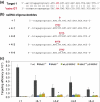Generation of a mouse mutant by oligonucleotide-mediated gene modification in ES cells
- PMID: 17142234
- PMCID: PMC1669774
- DOI: 10.1093/nar/gkl896
Generation of a mouse mutant by oligonucleotide-mediated gene modification in ES cells
Abstract
Oligonucleotide-mediated gene targeting is emerging as a powerful tool for the introduction of subtle gene modifications in mouse embryonic stem (ES) cells and the generation of mutant mice. However, its efficacy is strongly suppressed by DNA mismatch repair (MMR). Here we report a simple and rapid procedure for the generation of mouse mutants using transient down regulation of the central MMR protein MSH2 by RNA interference. We demonstrate that under this condition, unmodified single-stranded DNA oligonucleotides can be used to substitute single or several nucleotides. In particular, simultaneous substitution of four adjacent nucleotides was highly efficient, providing the opportunity to substitute virtually any given codon. We have used this method to create a codon substitution (N750F) in the Rb gene of mouse ES cells and show that the oligonucleotide-modified Rb allele can be transmitted through the germ line of mice.
Figures




References
-
- Capecchi M.R. Altering the genome by homologous recombination. Science. 1989;244:1288–1292. - PubMed
-
- Campbell C.R., Keown W., Lowe L., Kirschling D., Kucherlapati R. Homologous recombination involving small single-stranded oligonucleotides in human cells. New Biol. 1989;1:223–227. - PubMed
-
- Igoucheva O., Alexeev V., Yoon K. Targeted gene correction by small single-stranded oligonucleotides in mammalian cells. Gene Ther. 2001;8:391–399. - PubMed
-
- Kmiec E.B., Ye S., Peng L. Targeted gene repair in mammalian cells using chimeric oligonucleotides. Genet. Eng. (N.Y.) 2000;22:23–31. - PubMed
Publication types
MeSH terms
Substances
LinkOut - more resources
Full Text Sources
Other Literature Sources
Molecular Biology Databases

